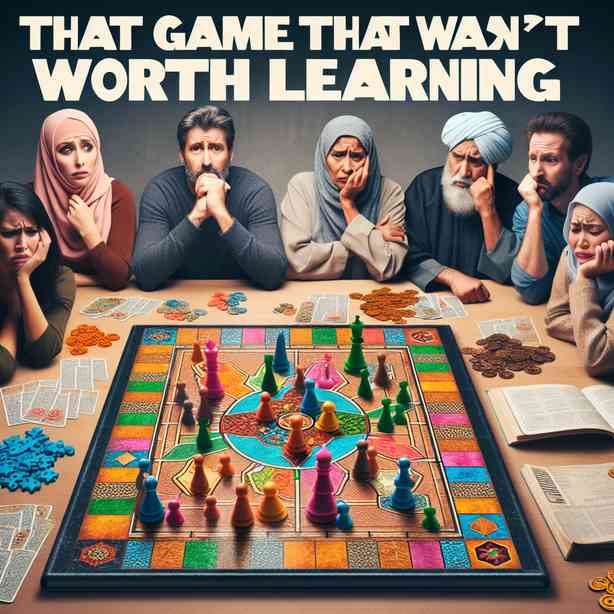
In the realm of gaming, there exists a phenomenon often referred to as “That Game That Wasn’t Worth Learning.” This phrase encapsulates the experience of investing time and energy into a game that ultimately fails to deliver on its promise, leaving players feeling disillusioned and frustrated. To thoroughly understand this phenomenon, we must delve into various aspects that contribute to a game’s perceived value and explore the reasons why some games are simply not worth the effort.
At the core of any engaging gaming experience lies the concept of immersion. Immersion refers to how deeply a player is absorbed in the game’s world, narrative, and mechanics. A successful game draws players in, offering them a captivating story, relatable characters, and an environment that feels both realistic and enticing. However, many games that fail to resonate often do so because they lack depth in these critical areas. For instance, a game with a weak storyline, poorly developed characters, and uninspired mechanics can quickly diminish a player’s interest, leading them to question why they invested their time in it.
Moreover, the learning curve plays a significant role in determining a game’s value. A challenging learning curve can be a double-edged sword; while it can foster a sense of accomplishment, it can also result in frustration if the game does not provide adequate guidance or if the difficulty feels artificial. Games that require extensive time and effort to master without offering meaningful rewards can leave players feeling disheartened. It’s essential for developers to strike a balance, creating a game that is challenging yet accessible, ensuring that players remain engaged throughout their journey.
Another critical aspect to consider is the community surrounding a game. The social component of gaming has grown exponentially in recent years, with players often seeking out shared experiences, whether through cooperative play or competitive engagement. A game that lacks a supportive and active community can feel isolating, making it harder for players to justify their time investment. Players often seek validation and a sense of belonging, and when a game fails to provide this, it can lead to feelings of regret over their decision to engage with it in the first place.
Additionally, the release and marketing strategies employed by game developers significantly impact player expectations. High-profile games, especially those backed by extensive marketing campaigns, can create a sense of anticipation that sets the bar impossibly high. When the final product falls short, players may feel deceived and emotionally invested in something that did not meet their expectations. This gap between expectation and reality can lead to considerable disappointment, further solidifying the sentiment that the game was not worth the effort to learn and master.
Another contributing factor is the potential for game updates and support from developers post-launch. In today’s gaming landscape, players expect developers to continue enhancing and refining their games long after release. A game that suffers from bugs, glitches, or a lack of sufficient updates can be perceived as abandoned, leaving players feeling that their time spent learning the intricacies of the game was in vain. Continuous support and engagement from developers can foster a loyal player base, while neglect can result in a swift decline in interest and engagement.
In the context of gaming, player goals and motivations play a pivotal role in how games are perceived. Some players seek to master every aspect of a game, while others may be content with casual play. When a game does not align with a player’s goals—whether it be achievement hunting, competitive play, or simply enjoying the narrative—it can lead to a mismatch in expectations. This disconnect can ultimately result in frustration and disappointment, as players may find themselves questioning the value of their efforts.
Looking at it from a broader perspective, the gaming industry is an ever-evolving landscape, filled with innovation and creativity. However, it is also important to recognize that not every title will resonate with every player. Personal preferences, experiences, and individual gaming styles all contribute to the diverse tapestry of player experiences. Therefore, a game that may not seem worth learning for one person might have a different value for another, which adds a layer of complexity to this discussion.
Ultimately, the context of “That Game That Wasn’t Worth Learning” serves as a reminder of the importance of thoughtful game design and player engagement. As gamers, it is crucial to approach new titles with an open mind while also learning from our experiences. Developers must strive to create content that respects players’ time and investment while fostering a positive and enriching gaming culture. By advocating for quality and meaningful experiences, we can help shape the future of gaming, ensuring that players feel their efforts are worthwhile.
As we continue to navigate the world of gaming, let’s keep in mind that our experiences, both good and bad, shape our understanding of what makes a game truly special. By sharing our stories and insights, we contribute to a community that values thoughtful engagement and fosters a shared appreciation for the art of gaming. Embracing this journey together, we can ensure that we minimize encounters with those games that aren’t worth learning, allowing us to invest our time and energy into truly rewarding experiences.


